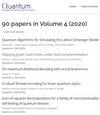高斯态的光子数矩和累积量
IF 5.1
2区 物理与天体物理
Q1 PHYSICS, MULTIDISCIPLINARY
引用次数: 0
摘要
我们开发了以光子数为基础测量高斯状态的矩和累积量的闭式表达式。我们用循环哈夫尼函数来表示高斯态的光子数矩,该函数应用于代表图形邻接度的$(0,1)$矩阵时,可以计算完全匹配的次数。同样,我们用蒙特勒表示光子数累积,这是一个新引入的矩阵函数,当应用于$(0,1)$矩阵时,可以计算该图的哈密顿循环数。基于这些图论联系,我们证明光子数矩和累积量的计算是 #P 难的。此外,我们还提供了一种指数时间算法来计算蒙特利尔矩(以及累积量),这与众所周知的哈夫尼斯结果相吻合。然后,我们证明,当均匀有损干涉仪的每个输入端都输入位移为零的相同单模高斯态时,除了第一个态之外,所有奇阶累积量都为零。最后,我们利用推导出的表达式来研究高斯玻色子采样设置中不同输入状态下四阶以下累积量的分布,在这个设置中,$K$相同的状态被输入到$\ell$模式干涉仪中。我们分析了累积量与输入状态类型(挤压态、有损挤压态、压扁态或热态)的函数关系,以及与非真空输入数量的函数关系。我们发现,在模仿有损或无损挤压态的光子数累积量方面,热态的表现比其他经典态(如压扁态)差得多。本文章由计算机程序翻译,如有差异,请以英文原文为准。
Photon-number moments and cumulants of Gaussian states
We develop closed-form expressions for the moments and cumulants of Gaussian states when measured in the photon-number basis. We express the photon-number moments of a Gaussian state in terms of the loop Hafnian, a function that when applied to a $(0,1)$-matrix representing the adjacency of a graph, counts the number of its perfect matchings. Similarly, we express the photon-number cumulants in terms of the Montrealer, a newly introduced matrix function that when applied to a $(0,1)$-matrix counts the number of Hamiltonian cycles of that graph. Based on these graph-theoretic connections, we show that the calculation of photon-number moments and cumulants are #P-hard. Moreover, we provide an exponential time algorithm to calculate Montrealers (and thus cumulants), matching well-known results for Hafnians. We then demonstrate that when a uniformly lossy interferometer is fed in every input with identical single-mode Gaussian states with zero displacement, all the odd-order cumulants but the first one are zero. Finally, we employ the expressions we derive to study the distribution of cumulants up to the fourth order for different input states in a Gaussian boson sampling setup where $K$ identical states are fed into an $\ell$-mode interferometer. We analyze the dependence of the cumulants as a function of the type of input state, squeezed, lossy squeezed, squashed, or thermal, and as a function of the number of non-vacuum inputs. We find that thermal states perform much worse than other classical states, such as squashed states, at mimicking the photon-number cumulants of lossy or lossless squeezed states.
求助全文
通过发布文献求助,成功后即可免费获取论文全文。
去求助
来源期刊

Quantum
Physics and Astronomy-Physics and Astronomy (miscellaneous)
CiteScore
9.20
自引率
10.90%
发文量
241
审稿时长
16 weeks
期刊介绍:
Quantum is an open-access peer-reviewed journal for quantum science and related fields. Quantum is non-profit and community-run: an effort by researchers and for researchers to make science more open and publishing more transparent and efficient.
 求助内容:
求助内容: 应助结果提醒方式:
应助结果提醒方式:


